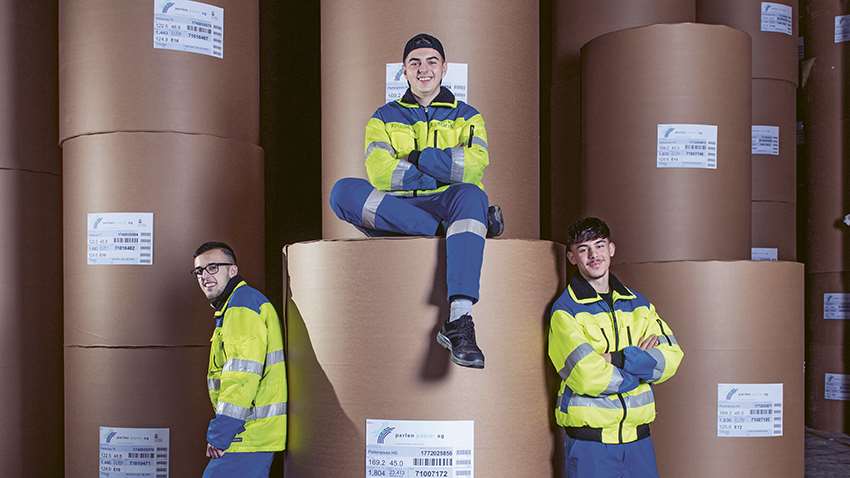Paper
Net sales and earnings show highly encouraging developments

While paper sales volumes were slightly down, higher sale prices helped raise the Paper Division’s net sales a substantial 66.5% to CHF 384 million. Despite steep increases in the costs of energy and raw materials, EBIT margin amounted to 19.5% .
Strategy
Digitalization has brought structural change to Europe’s printing paper market. The sizes and circulations of print newspapers have been diminishing for years as digital news distribution expands. As a result, the demand for graphic paper products has been falling since 2008. Suppliers have responded only belatedly by reducing capacities; and, as a consequence, the markets have seen fierce pricing competition. In response to these developments, the Paper Division has pursued a cost leadership strategy. The division possesses two advanced and high-performance paper machines. Paper production is also dependent on stable energy supplies. So the division structures its energy procurement, acquiring the electricity it needs on the liberalized market up to four years in advance, with the future volumes secured declining with the increasing futurity of the periods concerned.
Perlen Papier is now Switzerland’s only domestic recycler of waste paper. So sustainability has also become a key differentiator for the division. The paper is produced in Perlen with a carbon footprint which, according to the Ten Toes model of CEPI, Europe’s paper industry federation, is only a quarter the size of those of its European competitors. The division’s customers have also been offered totally carbon-neutral paper products since the beginning of 2021.
Market environment
Western European demand for paper declined in 2022, too. This was partially attributable to the continuing structural change described above. But it was also due to reductions in the sizes of printed products, as numerous publishing houses responded to the high paper prices with cost economies. Demand for newsprint in Western Europe declined 4.5% in 2022 to 3.1 million tonnes, while demand for coated magazine paper fell 18.2% to 2.2 million tonnes. Some 0.7 million tonnes of production capacity were withdrawn from the market in the course of the year. In addition, a months-long strike prompted a major production loss at one competitor at the beginning of the year, and put pressure on supplies of magazine paper in particular. A second competitor announced the sale of four of its five European paper factories, the first of which had changed owners by year-end. A further competitor also sold three of its European paper production plants. Some of the facilities sold may be reconfigured by their new owners to packaging paper production.
The situation on the recovered paper market remained highly challenging in 2022. With paper production still declining, less waste paper was fed back into the cycle; and with the popularity of online shopping continuing to grow, demand for recovered paper from the packaging industry remained constantly high, and volumes of waste graphic printing paper were redirected straight into the packaging cycle. The prices of recovered paper reached new historic highs in late summer 2022, and only started to fall again towards year-end. Meanwhile, energy prices continued to rise, and electricity costs multiplied. The prices of auxiliary materials and chemicals saw similarly steep increases.
Business development
The Paper Division sold 473 500 tonnes of printing papers in 2022, a volume slightly short of its prior-year level. Of this, 327 400 tonnes were of newsprint and 146 100 tonnes were of magazine papers. With market overcapacities reduced and with higher raw materials costs, paper prices had to be raised, and the division’s net sales for 2022 of CHF 384 million were a 66.5% improvement on the prior year, or 74.8% at constant currency. Perlen Papier’s share of the Western European paper sales market showed further slight year-on-year increases on both the newsprint and the magazine paper fronts, and now stands at around 10%.
As already mentioned, recovered paper, which is the division’s most important raw material, remained in short supply. Electricity costs were kept within reasonable bounds, thanks to the division’s structured procurement of its energy supplies over several years in advance. The division also achieved comprehensive optimizations and cost savings, and raised its EBITDA CHF 89 million to CHF 81 million. EBIT for the year amounted to CHF 75 million, after being substantially negative for the prior year following a one-time asset impairment. Some CHF 8 million was invested in the course of 2022 in renewing machinery and improving plant efficiencies. Year-end personnel numbers increased from the 357 of 2021 to 371.
Outlook
Industry associations expect to see a further decline in the demand for graphic printing papers in Western Europe in 2023. On the production side, the consolidation pressures remain. The Paper Division plans to invest some CHF 14 million in the course of the year in further enhancing its processes. The costs of energy and recovered paper are likely to remain high, with a corresponding impact on EBIT margin.
Under current expectations, the division’s net sales and EBIT for 2023 will fall short of their very high prior-year levels.
